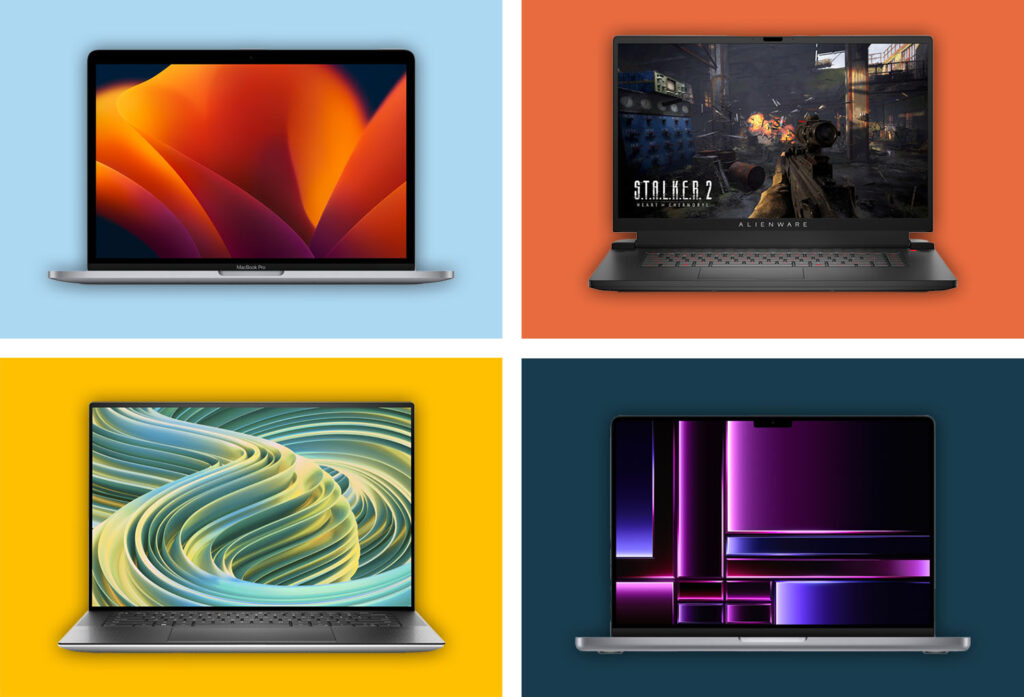In the ongoing debate between Windows and Apple, it's becoming clear that Windows brands are challenging Apple's long-held dominance. Notably, brands such as Alienware and MSI are earning recognition for outperforming Apple.
Interestingly, this shift is also becoming apparent in music production. The perceived edge Apple once held seems less significant now, apart from the exclusive use of Logic Pro software.
For music creators, the choice between Windows and Mac seems to be more about personal preference than distinct performance advantages. While Macs are typically more expensive, they do offer longer battery life, less weight, and quieter operation compared to Windows machines with similar specs.
Ultimately, it's about finding a laptop that offers the performance needed for seamless music production. Avoiding delays due to insufficient RAM is crucial. Despite many digital audio workstations (DAWs) stating 4GB of RAM as the minimum, in reality, this might not be enough unless you're limiting your tracks, plugins, and samples heavily.
The ideal laptop for music production depends on individual needs. If you're a producer constantly on the go, a lightweight laptop like the MacBook Pro could be a great fit. But if high performance is a priority and portability isn't an issue, the Alienware m15 might be your best bet.
This guide aims to provide a selection of the best laptops to fit different music production needs, helping every producer find the right solution, regardless of their individual requirements or budget.
If you prefer a desktop PC because mobility isn't an issue for you, I recommend my article on the best desktop PCs and Macs for music production.
Alienware m15
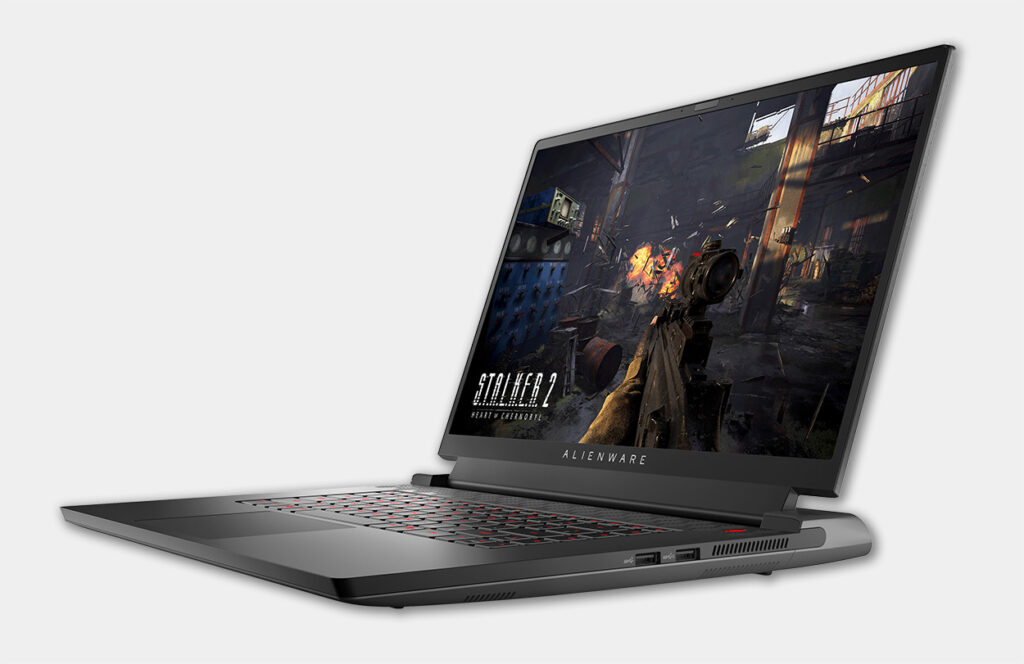
TECHNICAL SPECS
CPU: Intel Core i7-12700H
RAM: 16 GB - 64 GB
GPU: NVIDIA GeForce RTX 3060
Storage: M.2 PCIe 512 GB - 4 TB
Weight: 2.69 kg
MODELS / PRICES
ARGUMENTS IN FAVOR
- Superior performance
- Very good GPU
- Large screen
NEGATIVE POINTS
- Large and heavy
- The battery does not last long
First up is my personal top choice, the Alienware m15. This laptop, which has been a faithful companion to my music production for the past three years, is a monster. Both in terms of performance and size.
Let's get this out of the way: The 15 is a laptop, but not really small, light, or portable. But it has incredible specs that will easily handle even the largest DAW projects. With at least 16GB of RAM, an Intel Core i7-12700H and an NVMe SSD from 512GB to 4TB, there is enough power to work with near-zero latency - speaking from personal experience.
Admittedly, the NVIDIA GeForce RTX 3060 is a bit overkill and not really necessary for music production. But the trend is for more and more plug-ins to run on the GPU rather than the traditional CPU. And a lot of musicians are working with video to market themselves. And of course a GPU is very helpful there.
The screen is also huge at 15″ and the image quality is amazing - no wonder it is one of the best gaming laptops around.
Laptops like this are comparable to desktop PCs in top configurations - they have incredible power, but they don't last long on battery alone, or can't be used at 100%. But you have power everywhere these days, so that's not a problem for me personally (and I don't produce music on planes anyway). I think of the Alienware more as a portable desktop PC.
Anyone who values performance over portability will be 100 % happy with this laptop for music production. I have been using it for three years and have never reached its limits, even though I am constantly working with an audio buffer size of 32 samples, which is extremely CPU-heavy.
Link: Alienware m15 R7
Macbook Pro 14/16
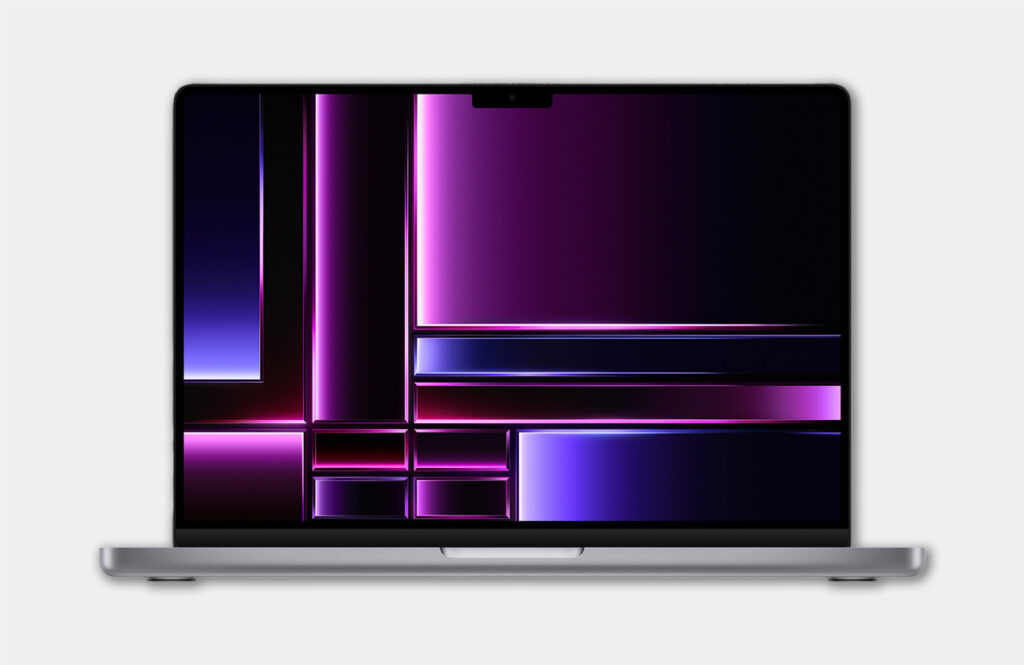
TECHNICAL SPECS
CPU: Apple M2 Pro or M2 Max
RAM: 16 GB - 96 GB
GPU: Apple M2 Pro or M2 Max
Storage: Up to 8 TB SSD
Weight: 1,6 kg
MODELS / PRICES
ARGUMENTS IN FAVOR
- Superior performance
- Still compact and light
- High quality Retina display
NEGATIVE POINTS
- Not cheap
For years, the MacBook Pro has been the undisputed king of the music production world. It continues to set new standards in the notebook industry, delivering exceptional performance in a design that is both compact and aesthetically pleasing, and a battery that lasts for hours.
The new 14- and 16-inch models are equipped with the all-new M2 Pro and M2 Max chips - a combination of CPU and GPU that is fully tuned to the notebook and offers almost unparalleled performance. We're on a similar performance level to Alienware, but in a much more compact package.
This laptop is ready for any kind of music production, no matter how big the project. With up to 64GB of RAM and an 8TB SSD hard drive, there's plenty of power for any music producer. And the best thing about MacBook Pro is the battery - I'm always amazed at how long it lasts, even with all that power.
This makes it ideal for producing music on the go without compromising performance. That's what makes this laptop so popular for music production - producers can easily go to any studio and work without being tied to a fixed location.
Link: MacBook Pro 14/MacBook Pro 16
Dell XPS 15
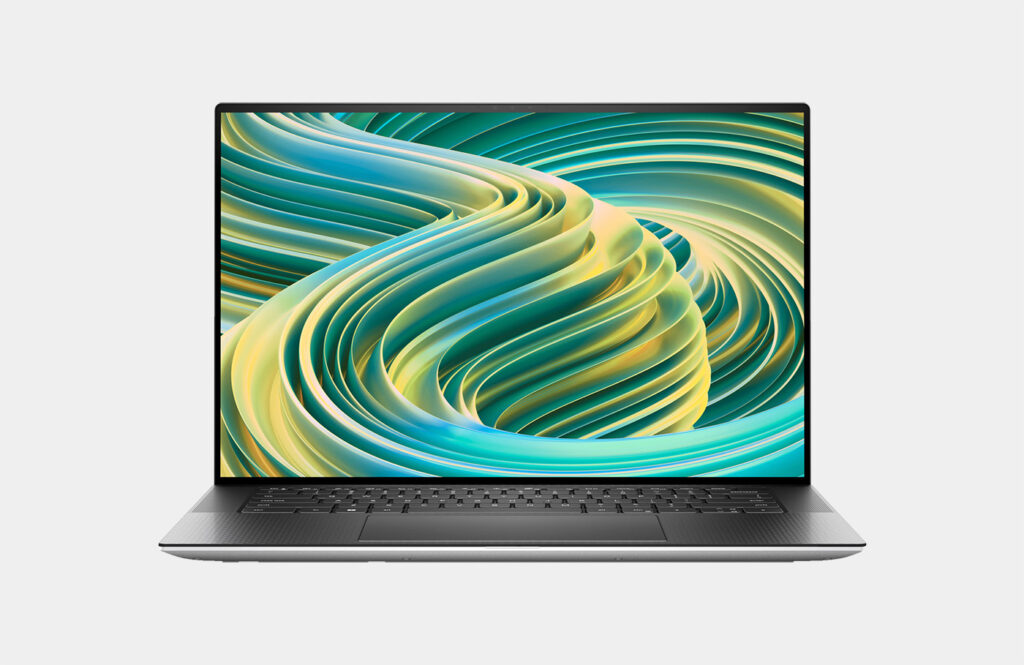
TECHNICAL SPECS
CPU: Intel Core i7-12700H
RAM: 16 GB - 64 GB
GPU: NVIDIA GeForce RTX 4050, 4060 or 4070
Storage: M.2 PCIe 512 GB - 4 TB
Weight: 1,86 kg
MODELS / PRICES
ARGUMENTS IN FAVOR
- Very good CPU performance
- Beautiful, compact design
- Touch display is a nice extra
NEGATIVE POINTS
- Gets too hot sometimes during intensive use
With a sleek design reminiscent of the MacBook Pro, the Dell XPS laptop delivers impressive performance. Equipped with the 12th generation Intel Core i7-12700H, this processor is one of the top recommendations for music production. It guarantees a latency-free process when recording, mixing and mastering music, making it an indispensable tool for professionals.
The performance is amazingly good - but unfortunately so good that the laptop gets a bit too hot from time to time. I say this from my own experience, as I have used this laptop for a long time. The components of the laptop are not damaged, but it can get uncomfortable if you put your hands on it or have the laptop on your lap.
You can choose from 16GB to 64GB of RAM, and you can also expand the SSD hard drive up to 4TB. On a fun note, the Dell XPS has surprisingly good built-in speakers. Obviously, for us audio producers, this is no comparison to studio monitors, but these are the best built-in speakers in a laptop I've ever heard. They deliver 3D sound that is incredibly spacious.
If the budget is tight, there is a 13″ version that is also very powerful and has very good specs - most producers should be able to get by with that.
Link: Dell XPS 15
Microsoft Surface Pro
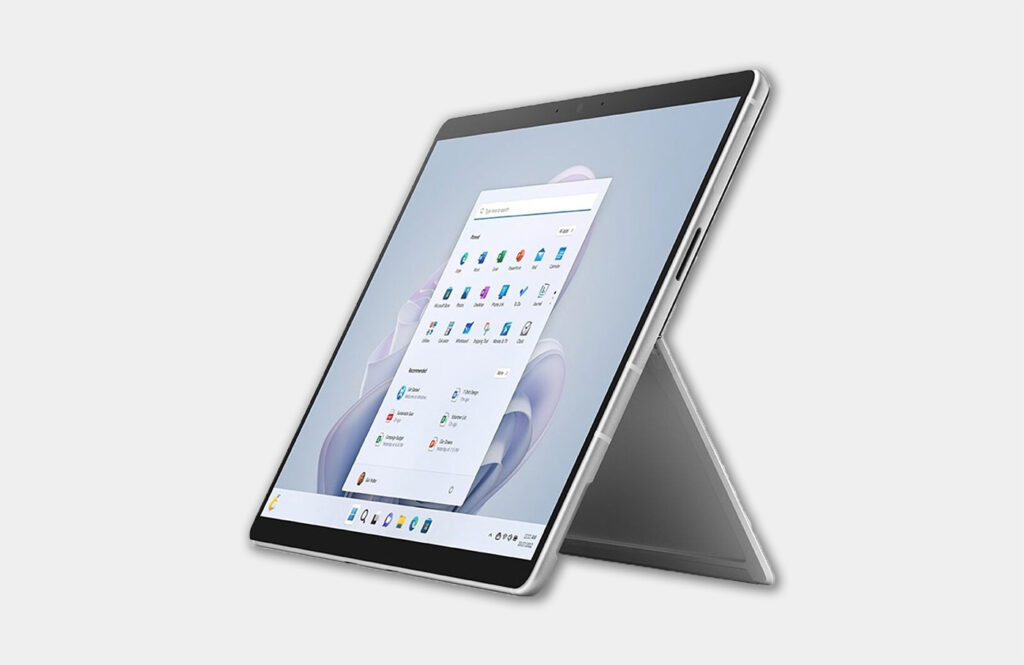
TECHNICAL SPECS
CPU: Intel Core i7 processor of the 12th generation
RAM: 16 GB - 32 GB
GPU: None
Storage: Up to 1 TB SSD
Weight: 0,87 kg
MODELS / PRICES
ARGUMENTS IN FAVOR
- Also works as a tablet
- Very light and portable
- Good performance
NEGATIVE POINTS
- Connection only via USB-C
Known for its top-notch operating systems, Microsoft has been expanding its portfolio since 2012 with the Surface line. What began as a simple tablet PC has evolved into a powerful laptop, ideal for music production.
The new 15s versions come with a 12th generation Intel Core i7, 8 or 16GB RAM and up to 1TB SSD - so you can work smoothly and effortlessly in any DAW. Even projects with hundreds of tracks are no problem for this music production laptop.
The Microsoft Surface is also the lightest laptop in the entire comparison - at only 870 grams, you can really take it anywhere. The battery life is also surprisingly long, at 15.5 hours. Of course, it won't last that long for intensive music production, but this tablet/laptop should easily last a good 6 hours.
The touchscreen is also a nice addition, giving you an analog feel when moving the faders. It has a 10-point multi-touch function - meaning you can use all 10 fingers at once - so you can work precisely with your fingers instead of a mouse.
Link: Microsoft Surface Pro 9
MacBook Pro 13
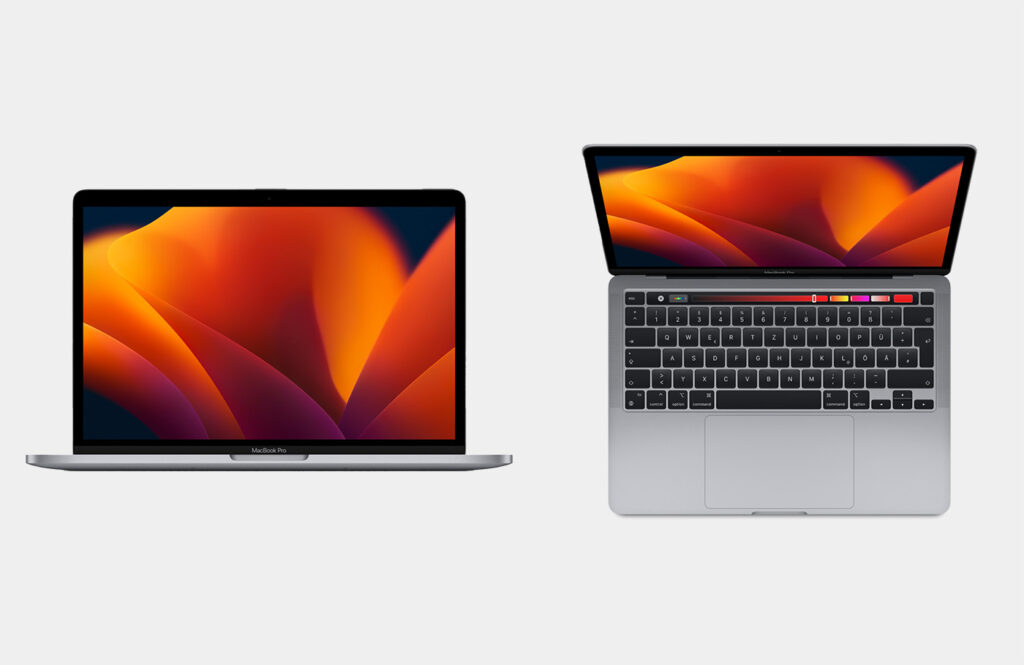
TECHNICAL SPECS
CPU: Apple M2
RAM: 8 GB - 24 GB
GPU: Apple M2
Storage: Up to 2 TB SSD
Weight: 1,4 kg
MODELS / PRICES
ARGUMENTS IN FAVOR
- Very good CPU performance
- Beautiful, compact design
- Stays quiet and cool
NEGATIVE POINTS
- Thunderbolt ports only
The 13-inch MacBook Pro "Classic" continues to be an attractive option for music creators who want to stay true to the MacOS ecosystem but are on a tighter budget. It features the powerful M2 processor for impressive performance.
With 8GB of RAM, expandable up to 24GB, and a 256GB SSD, expandable up to 2TB, it's a solid starting point. For additional storage, you can easily connect a fast external hard drive. Note, however, that MacBook memory is not expandable, so it's best to start with 16GB of RAM.
This version of the MacBook keeps the famous TouchBar, a polarizing feature - loved by some, hated by others. In my opinion, it never added much value, which is why Apple has decided to leave it out of newer models.
The synergy between the software and hardware inside every new MacBook is simply unbeatable. With the MacBook Pro 13, you can work with your DAW for hours without being connected and without crashing. The fact that you can get this kind of impressive performance out of such a compact machine never ceases to amaze me.
Link: MacBook Pro M2
Razer Blade 15
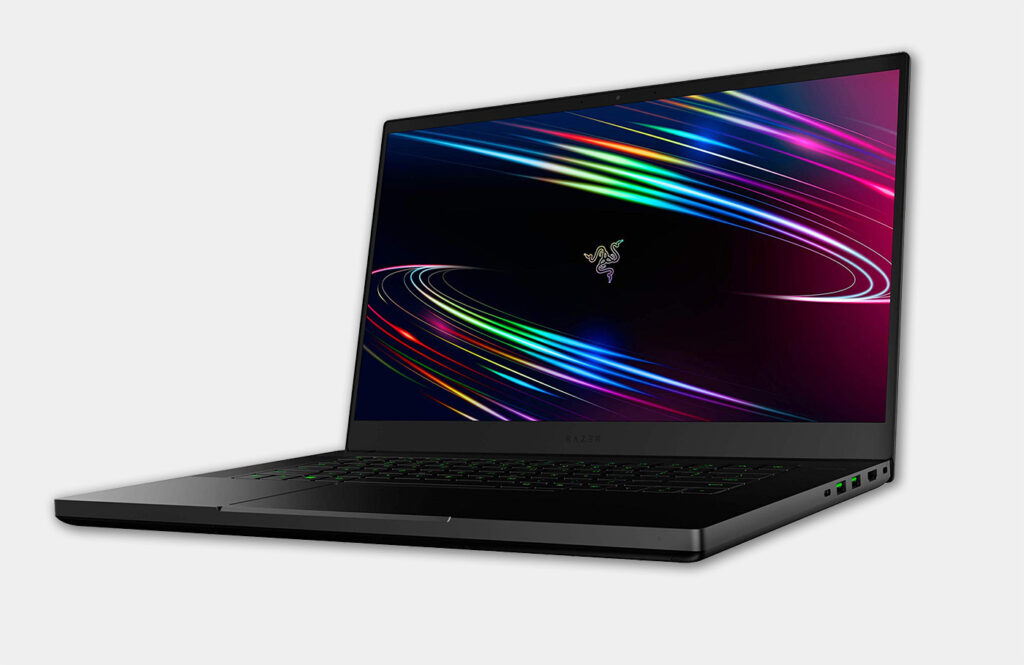
TECHNICAL SPECS
CPU: Intel Core i7-12800H 12th Generation
RAM: 16 GB or 32 GB
GPU: GeForce RTX 3060, 3070 Ti or 3080 Ti
Storage: 1 TB SSD
Weight: 2.01 kg
MODELS / PRICES
ARGUMENTS IN FAVOR
- Superior performance
- The powerful GPU is also well suited for gaming
- Despite its impressive specifications, the laptop is relatively compact
NEGATIVE POINTS
- The laptop gets quite loud at high performance
The Razer Blade 15 is another gaming laptop that is perfectly suited for music production. Equipped with a 12th generation Intel Core i7-12800H and up to 32GB of RAM, it offers enough power to tackle even the most demanding DAW projects.
Together with a latest-generation 1TB SSD hard drive (PCIe Gen 4 M.2), all of this is housed in a relatively compact case with a really chic design. Despite intensive use, the notebook stays cool, but this is accompanied by an increased noise level, which is typical for most gaming notebooks. Fortunately, the fan speed can be adjusted and turned down when needed, such as during voice recording, to keep things quiet.
Similar to the Alienware, you should not expect long battery life at maximum performance. The MacBook Pro is the rare exception, but that is due to the successful synergy of its own software and hardware.
So if you're looking for a powerful machine that can handle all your audio needs and much more (gaming, video editing, 3D modeling), you'll be very happy with the Razer Blade 15. It has similar performance to the Alienware, but in my opinion the Razer Blade 15 surpasses the Alienware in terms of aesthetics.
Link: Razer Blade 15
MSI Pulse 17
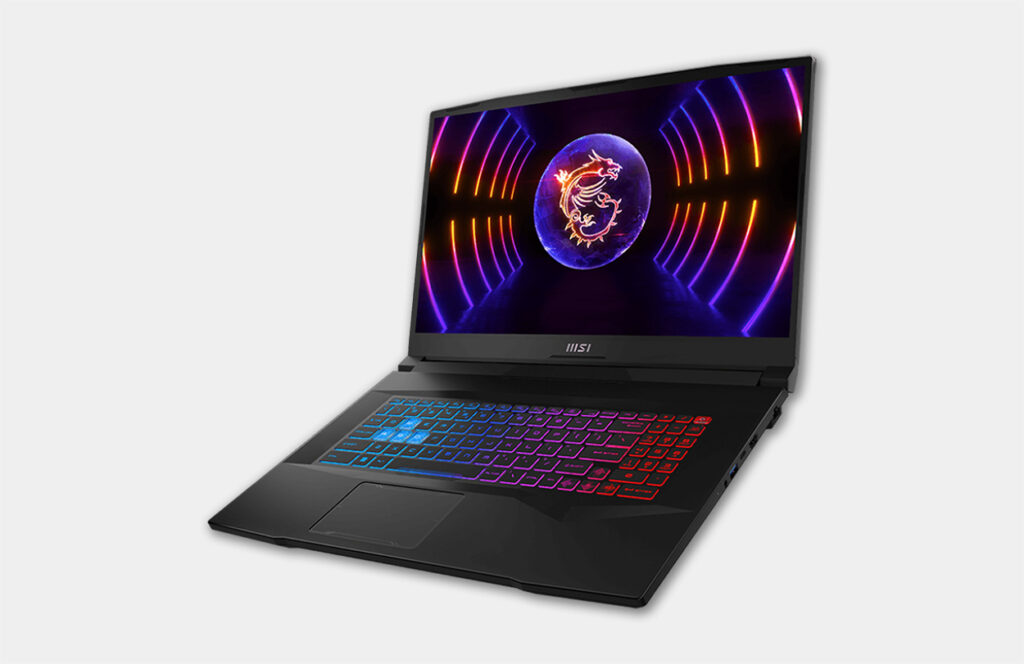
TECHNICAL SPECS
CPU: Intel Core i7-13700H
RAM: 16 GB
GPU: NVIDIA GeForce RTX 4070
Storage: 1 TB SSD
Weight: 2,7 kg
ARGUMENTS IN FAVOR
- Very good performance at a relatively low price
- The powerful GPU is also well suited for gaming
NEGATIVE POINTS
- Battery performance is not the best
MSI is a Taiwanese company that has been around since 1986 and is one of the best manufacturers of gaming laptops. The MSI is one of their mid-range laptops, but it is more than adequate for music production.
With an Intel Core i7-13700H, 16GB of RAM and a 1TB SSD, you have everything you need. The GPU is an NVIDIA GeForce RTX 4070, one of the most powerful available for laptops. It's a bit overkill for music production, but a nice extra for video editing or gaming.
As you would expect from a gaming notebook, the keyboard is illuminated with RGBs that you can customize. Looks great with LED strips in the studio!
This laptop for music production is in the same class as the Razer Blade or the Alienware - and here, too, the problem of battery life arises. During intensive use, the battery life is extremely short, but this is of course due to the enormous power consumption of the CPU and GPU.
But you have a laptop that can easily mix a 400-track project or record an orchestra with 50 microphones.
Lenovo Legion Pro 5
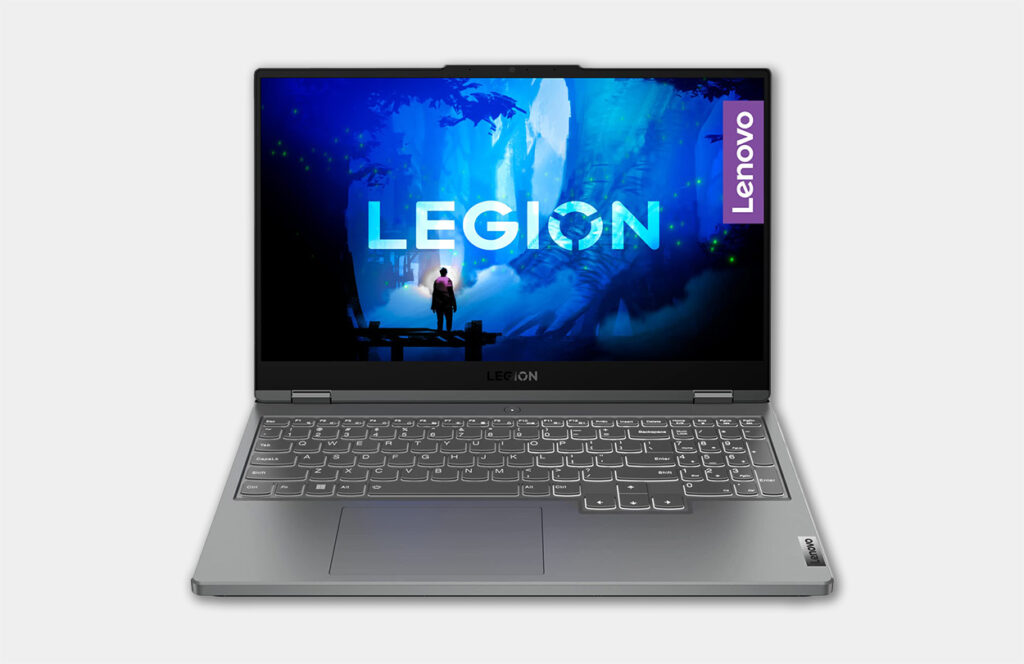
TECHNICAL SPECS
CPU: AMD Ryzen 7-6800H
RAM: 16 GB
GPU: NVIDIA GeForce RTX 3070
Storage: 1 TB SSD
Weight: 2,45 kg
MODELS / PRICES
ARGUMENTS IN FAVOR
- Very good performance at a relatively low price
- WQHD Display (2560 x 1600px)
NEGATIVE POINTS
- The fans are a little loud
- Gets warm when you work with it intensively
Lenovo has been one of the best-known PC and laptop manufacturers for years, and with the Legion series they have launched a gaming lineup that is very interesting in terms of specifications.
Especially noteworthy is the new "AI-optimized performance" with the Lenovo AI Engine+, which is said to provide more efficient and powerful performance. With an AMD Ryzen 7 7745HX and up to 16GB of RAM for just under €1,800, this notebook offers one of the best value for money.
The NVIDIA GeForce RTX3070 is not as powerful as the 4070 in other gaming notebooks, but that is not as important to us music producers, so you are saving money here. And this GPU is still powerful enough to edit video or play games smoothly.
The design may not be as pretty as other gaming laptops, but that's a matter of taste and doesn't really matter - what matters is the performance, and this laptop for music production definitely delivers. Thanks to the incredibly powerful AMD processor, even long sessions with small buffer sizes are no problem.
Another plus is the variety of connectivity options: 4 USB, 2 USB-C, HDMI, headphone/microphone and Ethernet inputs are available. Apple could learn a thing or two from this!
It's definitely worth considering if you're looking for a powerful gaming laptop for making music that's not too expensive.
Link: Lenovo Legion Pro 5
Acer Swift 3
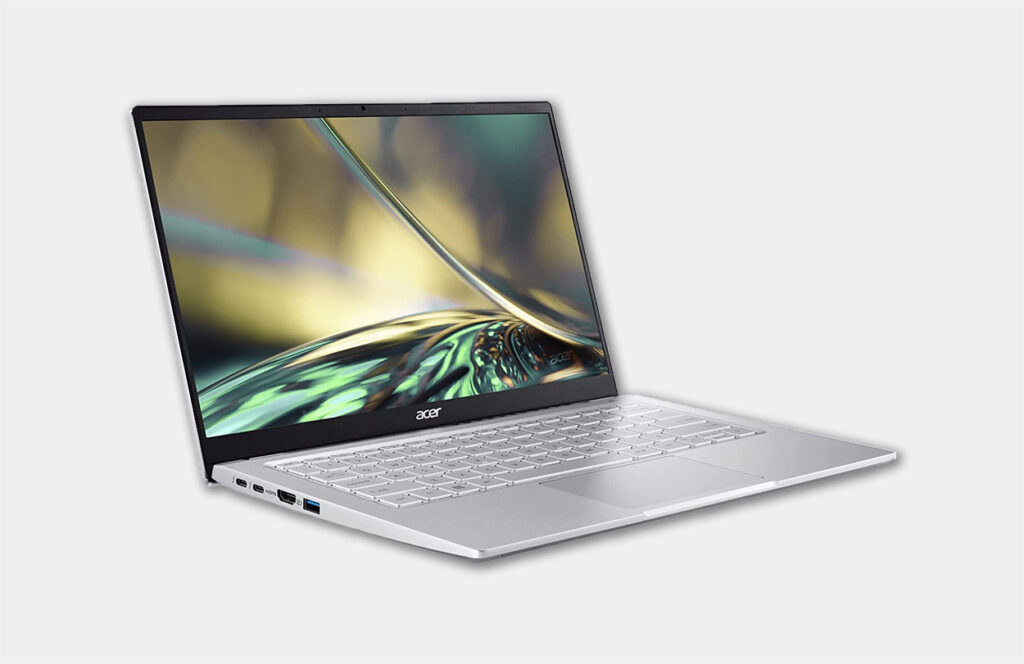
TECHNICAL SPECS
CPU: Inter Core i5-11300H
RAM: 16 GB
GPU: Intel Iris Xe Graphics
Storage: 512 GB SSD
Weight: 1,7 kg
MODELS / PRICES
ARGUMENTS IN FAVOR
- Extremely good value
- Best performance in the price segment
- Good battery life
NEGATIVE POINTS
- –
The Acer Swift 3 is the cheapest laptop on this list. With an Intel Core i5, 16GB RAM and 512GB SSD, it is the best laptop for music production under 1000€. The processor and RAM are most important for working with DAWs, and 16 GB and a fast 4.4 GHz i5 are good enough for that.
This should be enough for larger projects - maybe not in the 300 track range, but that should be the exception for most. Acer has managed to keep the price down by keeping the graphics equipment minimalistic, which will not be an obstacle for music producers. The screen quality may not be the highest, but the Full HD (1920×1080) 14-inch display offers plenty of space for tracks and plugins when working with the DAW.
The design is elegant and somewhat reminiscent of Apple's laptops. However, the Acer offers many connectivity options for such a small device (2x USB, 2x USB 3.1, HDMI, 3.5mm TRS), which is much more practical. However, the build quality is not as good as Apple's - again, Acer had to make compromises to keep the price down.
So if you're looking for an affordable laptop that's capable of producing music, and even slightly above the minimum requirements for doing so, the Acer Swift is definitely a good choice.
Link: Acer Swift 3
Macbook Air M2
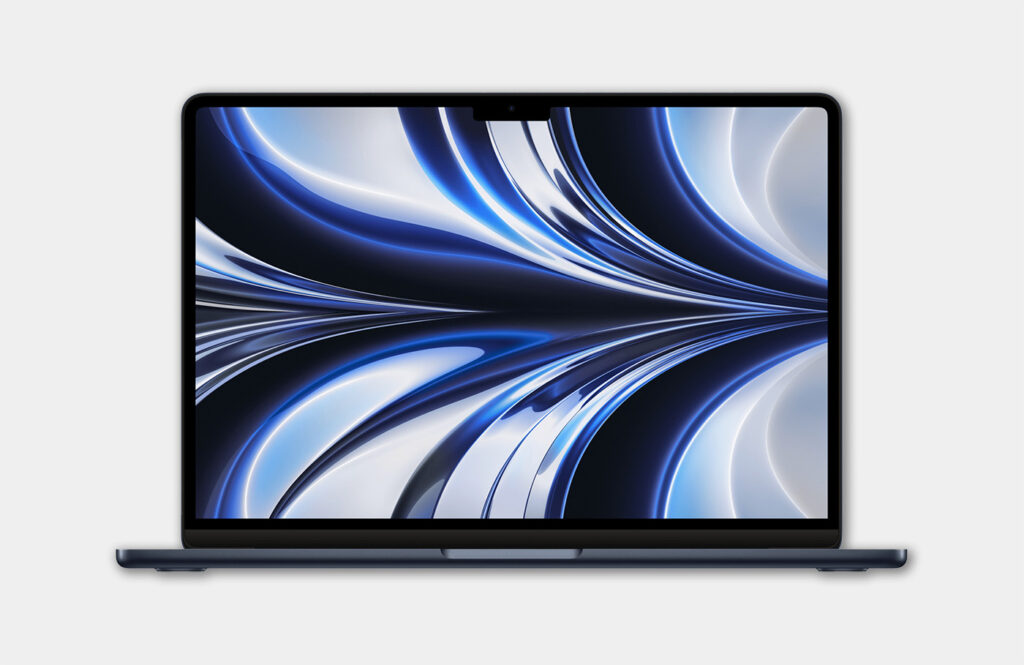
TECHNICAL SPECS
CPU: Apple M2
RAM: 8 GB
GPU: Apple M2
Storage: 256 GB SSD
Weight: 1,24 kg
MODELS / PRICES
ARGUMENTS IN FAVOR
- Very good CPU performance
- Light, compact and portable
NEGATIVE POINTS
- Thunderbolt ports only
The Macbook Air with the new M2 processor is a marvel - incredibly powerful, yet quiet and cool, with great battery life. Granted, it's not cheap, but compared to a MacBook Pro, it's a bargain.
The M2 processor, 8-24 GB RAM and 256 GB - 2 TB SSD are packed into a notebook that weighs only 1.24 kg, yet is extremely slim and looks very good. I would recommend music producers to choose at least 16 GB RAM. The size of the hard drive isn't necessarily important if you have external hard drives, but it should be well considered as you can't upgrade later.
While the specs may not sound spectacular, the incredible performance of the Apple M2 processors must be highlighted - this seamless integration of software and hardware gets the most out of every part. The performance of this laptop is unbelievable and leaves nothing to be desired for semi-professional producers.
So if you want to make music on the train, bus, or in the car, MacBook Air is the perfect choice. Its small size and light weight make it the perfect travel companion.
Link: MacBook Air M2
ASUS ROG Strix G16 (2023)
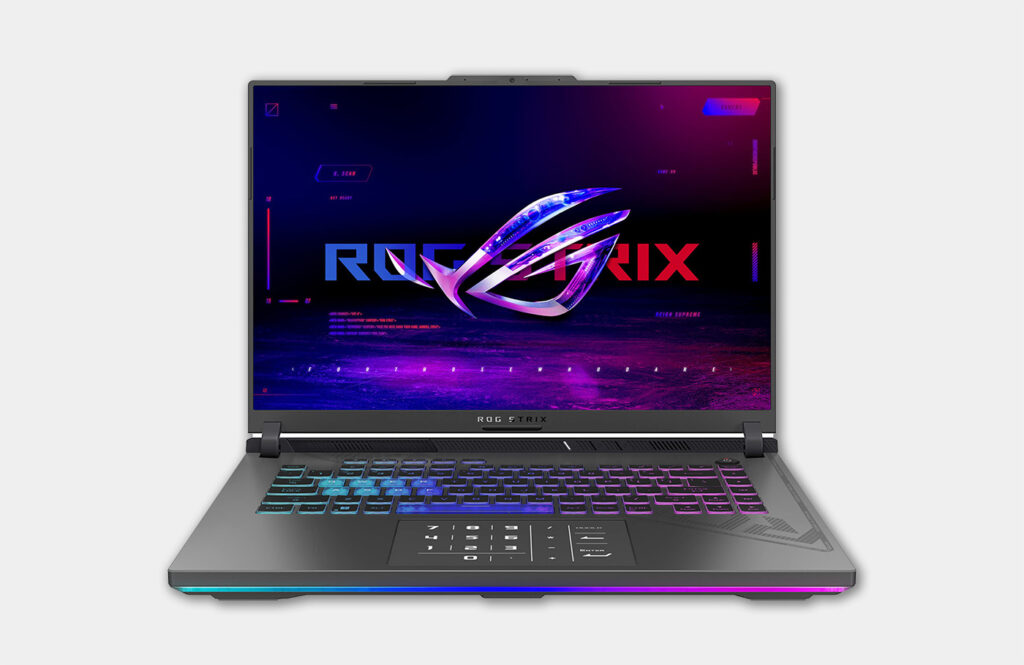
TECHNICAL SPECS
CPU: Intel Core i9-13980HX
RAM: 16 GB
GPU: NVIDIA GeForce RTX 4050
Storage: 1 TB SSD
Weight: 2,5 kg
MODELS / PRICES
ARGUMENTS IN FAVOR
- Very good performance for a relatively low price
- Stays cool even at high power
NEGATIVE POINTS
- The fans are loud
The ROG Strix is Asus' flagship. It is a real beast: With an Intel Core i9-13980HX, you have the best processor you can have for music production. Combine that with 16GB of RAM (expandable to 32GB) and you have a laptop that can do just about anything you set your mind to.
It has enough power to theoretically mix 1000 tracks in a project in the DAW - the i9 is known for its incredible performance. The fans aren't particularly quiet, but that's no surprise, as a processor like this needs proper cooling. However, the ROG uses a smart cooling system based on Thermal Grizzly Conductonaut Extreme liquid metal, which ensures that the notebook stays cool even during intensive use.
The interesting thing about this laptop is that the number pad is integrated into the trackpad, so it functions as a mouse and keyboard. Together with the bright colors, this gives the laptop a very futuristic look.
The built-in speakers are also surprisingly good, and can be useful for checking the mix on another monitoring system. There are even 2-way speakers with tweeters and woofers and (virtual) 5.1 Dolby Surround! That's quite impressive for a laptop.
The ASUS ROG Strix G16 is definitely in the upper league of laptops for music production and is therefore recommended for anyone who can afford it.
Link: ASUS ROG Strix G16 (2023)
Acer Predator Helios 300
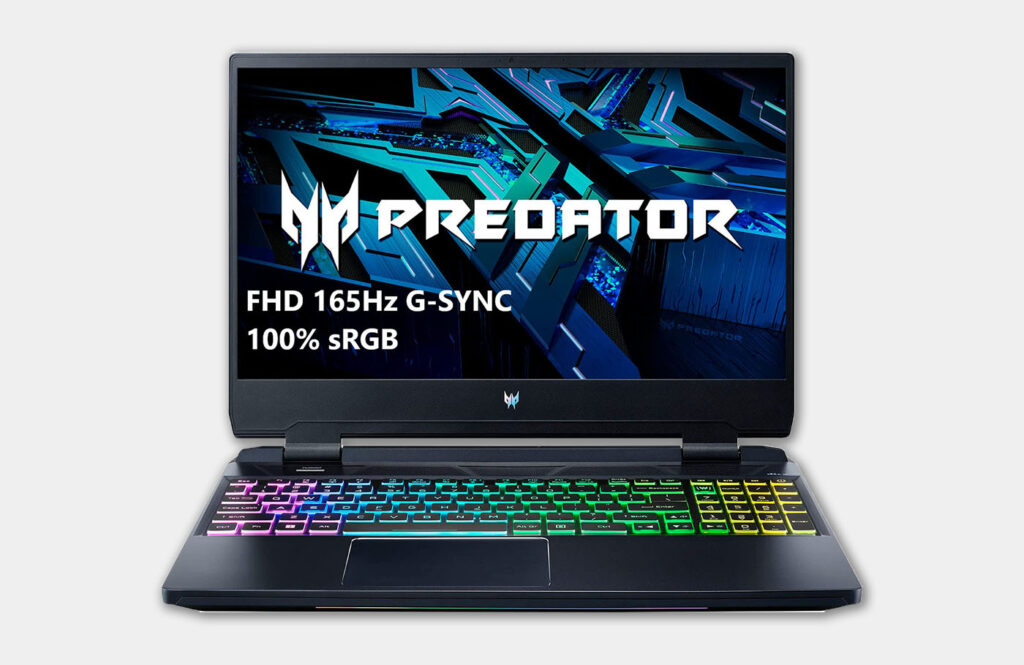
TECHNICAL SPECS
CPU: Intel Core i7-12700H
RAM: 16 GB
GPU: NVIDIA GeForce RTX 3060 with 6 GB
Storage: 512 GB SSD
Weight: 3 kg
MODELS / PRICES
ARGUMENTS IN FAVOR
- Good price-performance ratio
- Strong performance
NEGATIVE POINTS
- Fan is quite loud
The Helios 300 from Acer's Predator series is actually an entry-level gaming model, but it has enough power to handle demanding DAW projects with ease. The 12th generation Intel Core i7 can be clocked up to 4.7 GHz thanks to Turbo Boost technology, which is not a given in this price range and is extremely helpful for music production.
For just under €1700, you get the Helios 300 with 16GB RAM and 512GB SSD, but you can easily expand both yourself (RAM up to 32GB and the hard drive up to 4TB). The standard configuration should be fine for now.
The screen is super sharp and the colors are very present. Personally, I think the whole design is very nice and very well done - it looks a bit like a spaceship, and that's how it should be for gaming notebooks.
The fans on this laptop, like most gaming laptops, are quite loud and can be a bit annoying in quiet environments. But these are the compromises you have to make if you want such a powerful machine that won't burn out at work.
This laptop is also hard to beat in terms of price/performance, as it offers exactly what is important for musicians (strictly speaking, you could also take a weaker GPU) for 1700€, and you are also on the safe side for the next few years, as you can easily upgrade the components yourself.
Link: Acer Predator Helios 300
What to consider when choosing a laptop for music production?
Music production and everything related to it (composing, recording, mixing, mastering) is very CPU-intensive for a computer, unlike other work like video editing, which can benefit enormously from a powerful GPU. This is not the case when working with a DAW, and for this reason the GPU is not as important, while the CPU plays a very important role.
In addition, the number of cores is not as important as the speed of the CPU. So always pay attention to how many GHz the CPU is clocked at and if it is overclockable. The more, the better.
A faster CPU means less latency and the ability to work with smaller buffer sizes without crashing the computer. Therefore, a good CPU is a must if you want to record or play in melodies, as you don't want to have delays in monitoring and therefore have to reduce the buffer size.
What is better for music producers, Mac or Windows?
Both operating systems are excellent for production purposes - neither is better than the other. It is purely a matter of taste. Apple has the advantage that its laptops are extremely powerful, yet relatively small and portable.
Of course, there are Windows laptops like those from Alienware or MSI that are just as powerful or better, but they're much bigger and louder, and the battery doesn't last as long as the MacBook.
But Apple has the disadvantage that you can't upgrade the hard drive and RAM yourself, and they're extremely expensive. And since you can't upgrade, you are forced to choose a large hard drive and a lot of RAM, which makes the laptop even more expensive.
That's why I personally haven't bought an Apple since 2012 - the 2012 version was the last MacBook Pro that you could upgrade yourself. The Windows laptops also have more and more ports - with Apple you still have to buy the USB-C adapter from Apple to connect the laptop to USB devices.
So: Apple laptops are extremely powerful, small, light, quiet, and portable, but expensive. Windows laptops can be just as powerful or better, but they are bigger, heavier, and noisier, but much cheaper.
Which CPU is the best for music production?
Of course, if you choose Apple, your laptop will have an Apple CPU (M2, M2 Pro, or M2 Max), and they're really fast. Very fast. These Apple CPUs are perfectly tuned to the software and the rest of the hardware, so they deliver incredible performance for the small size of the laptop.
So when you buy a MacBook Pro, you can be sure you won't have any problems working with your DAW. You can record melodies from your MIDI keyboard without latency, or record vocals/instruments from microphones. That is, of course, if you have a good audio interface.
If you choose Windows, there are two main CPU manufacturers: Intel and AMD. Intel offers the i3, i5, i7, and i9 processors. The i7 and i9 are especially good for music production because they are very fast, particularly each individual core. And that's what we want.
AMD's processors have similar names (Ryzen 3, Ryzen 5, Ryzen 7, Ryzen 9) and offer similar performance. However, for music production, the Intel processors are slightly better - the AMD processors offer better multi-core performance, which is better for gaming or video editing, but not for DAW work.
Music production actually benefits more from the higher speed of the individual cores/threads, and in this regard Intel is better. But the difference is really minimal and not noticeable for most producers who will never reach the limits of an AMD processor.
So if you have a choice, I'd prefer an Intel processor, but I wouldn't rule out a laptop just because it has an AMD processor. If you play games or edit video, an AMD processor may actually be better.
How much RAM does my laptop need to produce music?
With 8GB of RAM, you can run most popular DAWs, but for semi-professional use, 16GB is the minimum. Every plugin you open consumes RAM, as does every track you add to your project. If you are playing a sample-based instrument (such as Native Instruments' Kontakt), the samples are stored in RAM for quick access when playing on the keyboard.
Everything needs RAM - the more RAM you have, the more tracks and plugins you can run simultaneously without slowing down your laptop.
You should also check to see if the laptop allows you to upgrade the RAM yourself later. If so, you can start with less RAM and buy more later.
Most of the Windows laptops on this list are capable of this, but Apple laptops are not. So if you buy an Apple, think carefully about how much RAM you get - I would always recommend at least 16GB.
How much storage do I need?
Now all the hard drives in laptops in this price range are SSDs, and all of them are extremely fast. Especially the M.2 PCIe SSDs that are built into all high-end Windows laptops and MacBooks. This is especially important for accessing large sample libraries quickly and without latency.
The size of your hard drive depends on your needs, the number of projects you have, and the number of samples and plugins you have. The more space you have, the more you can store - but your laptop won't necessarily be faster if you have a larger hard drive.
You can also buy an external Thunderbolt/USB-C hard drive if you run out of space - these are also very fast and can be used to store sample libraries.
Again, like memory, most Windows laptops let you upgrade your hard drive later, but not MacBooks. So Apple forces you to buy a bigger hard drive from the start, and they are not cheap.
Conclusion
No matter which laptop you end up with, if it meets the minimum requirements, you should be on the safe side. Ultimately, it is a matter of personal taste, which operating system you prefer, which design you like best, or whether you also want to play games with the laptop.
Keep reading:





